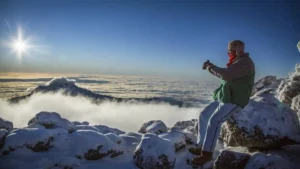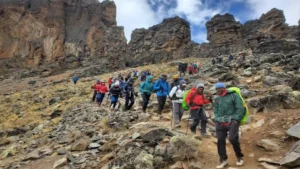We deliver responsible, sustainable tourism
The Best Expert Guide on Kilimanjaro
Home » Best Month to Hike Kilimanjaro: Weather & Success Tips
Rating:
The best months to hike Kilimanjaro fall into two distinct dry seasons that offer optimal climbing conditions. Furthermore, these periods provide clear skies, stable weather, and the highest success rates for reaching Uhuru Peak.
Mount Kilimanjaro can be climbed year-round, but certain months offer better weather, higher summit success rates, and fewer crowds. Several factors influence the ideal climbing period, including temperature, trail conditions, crowd levels, and gear requirements, but weather, especially rainfall, has the greatest impact.
Located in an equatorial climate zone, Kilimanjaro experiences only two distinct seasons: wet and dry. Each season offers unique advantages, so choosing the right timing is crucial.
In this article, you’ll learn about Kilimanjaro’s climbing seasons, the pros and cons of each, a detailed month-by-month overview, and expert recommendations to help plan your climb.

January ranks as one of the best months to climbing Mount Kilimanjaro. Moreover, the weather delivers warmer temperatures and minimal rainfall, creating excellent conditions for climbers. Additionally, you’ll encounter fewer crowds on the mountain trails, making this period ideal for those seeking a more peaceful climbing experience. Trails tend to be busy, especially around New Year, so it’s a good idea to book early if you’re planning a holiday-season trek. Conditions are comfortable overall, but expect company at campsites and on the trails.
February continues the favorable weather patterns from January. Similarly, the conditions remain dry and warm, with clear visibility that enhances scenic views of the African landscape. As a result, this month offers some of the most comfortable hiking temperatures on the mountain.
Trail traffic remains high, similar to January, so campsites and paths can feel busy. Still, the excellent weather and scenic views make February a popular choice for many climbers.
*Because Kilimanjaro is near the equator, the difference between summer and winter temperatures is relatively small, typically around 5–10°C (9–18°F).
March represents the final stretch of the short dry season. However, weather conditions start shifting toward the end of the month, but early March still provides excellent climbing opportunities with manageable temperatures and low precipitation levels. Therefore, March remains among the best months to hike Kilimanjaro for those seeking favorable conditions. However, the weather on Kilimanjaro can be unpredictable, so quality rain gear is essential. Fewer climbers choose this time, making for a quieter experience.
June brings the start of the long dry season. Clear skies are common, with little rainfall and cold nights above 3,500 m (11,500 ft). The air feels crisp, and visibility is excellent, especially early in the morning. While climber numbers are rising, June is still less crowded than July or August, making it a favorite among outfitters for its calm, stable conditions.
July delivers some of the coolest temperatures on Kilimanjaro, creating comfortable hiking conditions. Furthermore, the month features minimal rainfall and clear skies, though temperatures drop compared to earlier months.
August and September represent peak climbing season with the driest conditions of the year. Consequently, these months attract the largest crowds but offer the most stable weather patterns. Therefore, success rates peak during this period due to optimal conditions. The mountain feels lively, and while crowd levels are high, especially on Marangu, Machame, and Lemosho, some climbers find the energy motivating. For a quieter option, also consider the Rongai or Northern Circuit routes.
October provides an excellent balance of good weather and smaller crowds. In contrast to peak season, as the climbing period winds down, you’ll find excellent climbing conditions with fewer hikers on the trails. Consequently, October ranks among the best months to hike Mount Kilimanjaro for those avoiding crowds. Conditions vary more than in previous months, so packing layers and waterproof gear is key. October offers a nice balance of space and scenery — especially for those willing to take a bit of weather uncertainty in stride.

Mount Kilimanjaro’s weather follows predictable seasonal patterns that directly impact hiking conditions. Moreover, understanding these patterns helps determine the best month to hike Kilimanjaro:
Understanding Kilimanjaro’s rainfall patterns helps you choose the best month for your adventure. Additionally, these patterns directly influence which months offer the best time to hike Kilimanjaro:
These months bring heavy rainfall to Mount Kilimanjaro’s lower slopes, creating slippery trail conditions and reduced visibility. As a result, the wet season makes hiking significantly more challenging and decreases summit success rates. Therefore, April and May represent the worst months to hike Kilimanjaro for most climbers.
Climbing during this season, the Rongai Route is a popular choice thanks to its location on the drier northern side of the mountain, which lies in the rain shadow of Kilimanjaro. This area receives less precipitation than the southern slopes, making trekking conditions more stable. Another good option is the Marangu route with its hut accommodations.
While less intense than the long rainy season, this period still presents challenging conditions with frequent precipitation and cloud cover that obscures mountain views. Nevertheless, some experienced climbers attempt these months despite the increased difficulty. However, these months don’t qualify as the best time to hike Mount Kilimanjaro for most adventurers.
Choose January, February, July, August, or September when you prioritize stable weather patterns and clear skies. Furthermore, these months offer the most predictable conditions for successful summit attempts and represent the best time of year to hike Mount Kilimanjaro.
January, February, June, and October provide excellent weather while avoiding peak tourist seasons. Additionally, you’ll experience better trail conditions with fewer hikers sharing the routes. Therefore, these months offer the best month to hike Kilimanjaro experience for solitude seekers.
January through March and July through September deliver the clearest skies and best visibility for capturing stunning photographs of Kilimanjaro’s diverse landscapes and surrounding plains. Moreover, these months represent the best time to hike Mount Kilimanjaro for visual experiences.
The optimal window spans two distinct periods that represent the best months to climb Kilimanjaro:
January emerges as the single best month for most climbers, offering optimal conditions that define what is the best month to climb Kilimanjaro:
Beginners: Choose January, February, or October for forgiving weather conditions and moderate crowd levels. These months represent the best time to hike Mount Kilimanjaro for first-time climbers.
Experienced hikers: Consider June, July, or September for optimal technical conditions, though expect more challenging weather in June and July. These months offer the best month for Kilimanjaro veterans seeking adventure.
Photographers: January, February, August, and September provide the clearest conditions for capturing memorable images. Therefore, these months represent the best time of year to climb Mount Kilimanjaro for visual documentation.
August is usually the busiest month on Kilimanjaro. It coincides with summer holidays in Europe and North America, drawing large numbers of international trekkers. Campsites fill up quickly, and popular routes like Machame, Marangu, and Lemosho can feel congested, especially around Barafu and Barranco camps. While the energy on the mountain can be exciting, those seeking solitude may prefer shoulder seasons or opt for less-traveled routes like Rongai or the Northern Circuit.
Summiting under a full moon is one of Kilimanjaro’s most memorable experiences. The moonlight often provides enough natural illumination to hike without a headlamp, especially above the cloud line. This not only enhances visibility but also adds a surreal, dreamlike quality to the final push to Uhuru Peak. Full moon dates tend to be in high demand, so early planning is recommended.
For those who prefer darker skies, climbing around the new moon offers an equally breathtaking experience. With almost no light pollution and clear mountain air, the night sky over Kilimanjaro reveals an extraordinary view of the Milky Way and southern hemisphere constellations. Stargazing from high-altitude camps can be a magical part of the journey — and a highlight for photography lovers.
Christmas and New Year are among the busiest times on Kilimanjaro. Routes, camps, and park gates see a major spike in activity, and prices for tours and lodging may also rise. If your schedule allows, consider avoiding peak holiday periods for a more peaceful and flexible experience. If you do plan a holiday summit, be sure to book well in advance.
When determining the best time to go to climb kilimanjaro, consider these key factors that influence the best time to hike Mount Kilimanjaro:
The best Time to climb Kilimanjaro ultimately depends on your personal preferences for weather, crowds, and overall experience goals. Furthermore, January consistently ranks as the top choice for balanced conditions, while October offers an excellent alternative for those seeking fewer crowds with reliable weather patterns. Therefore, both months represent excellent choices when considering what is the best month to climb Kilimanjaro for your adventure.
Hiking Kilimanjaro is a leading adventure company specializing in safe, guided climbs to the summit of Mount Kilimanjaro, offering expert guides and unforgettable trekking experiences.